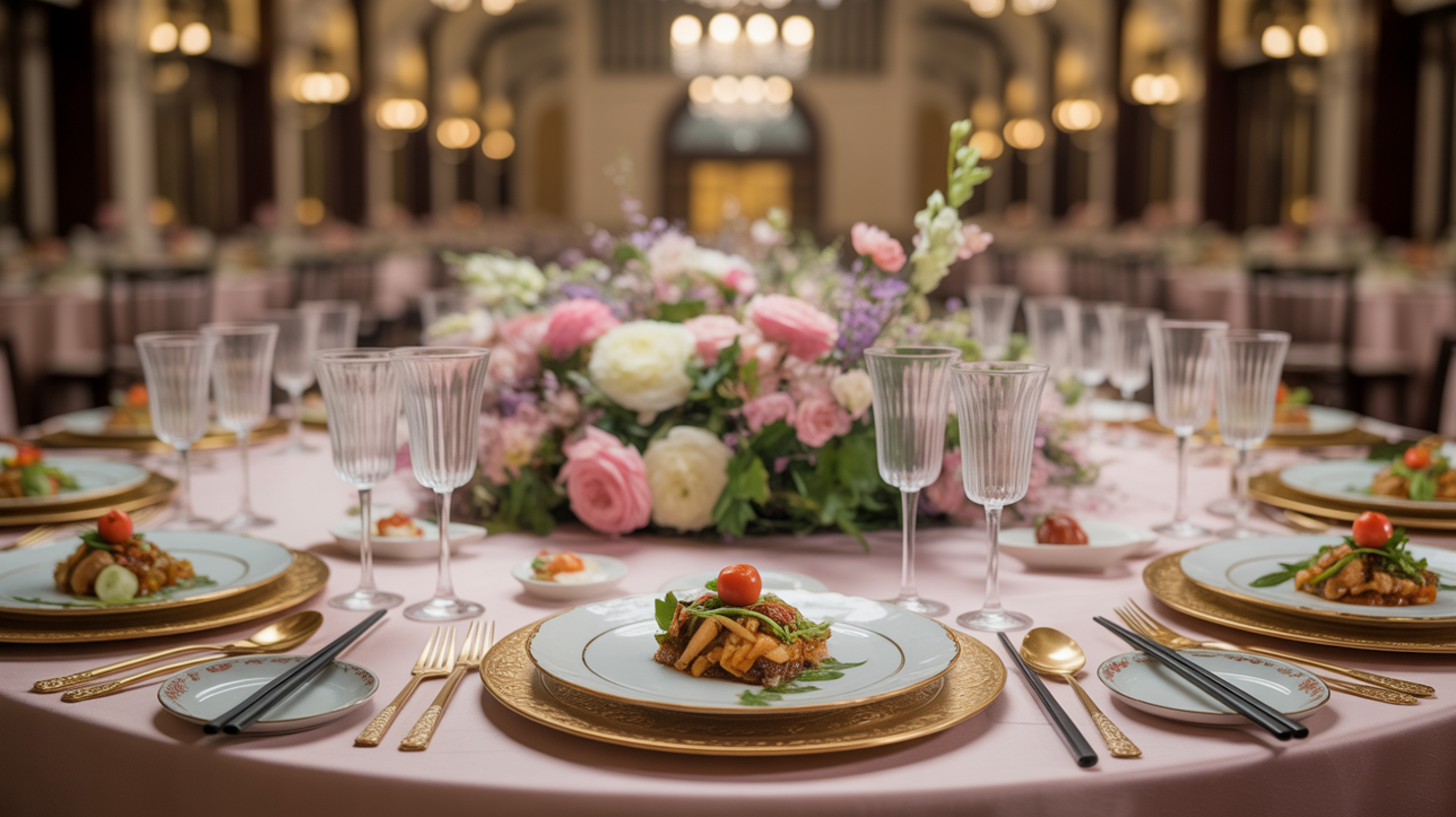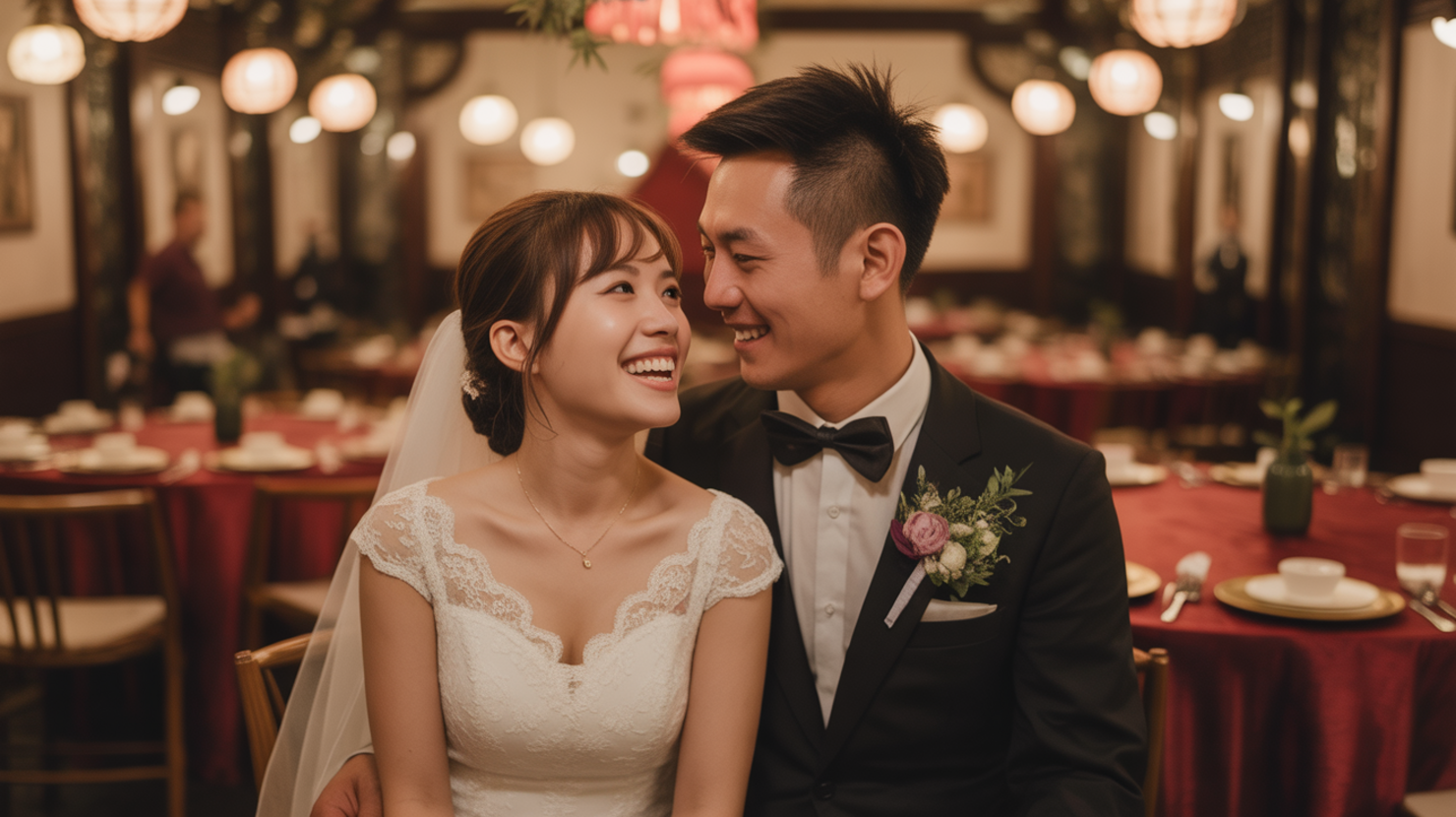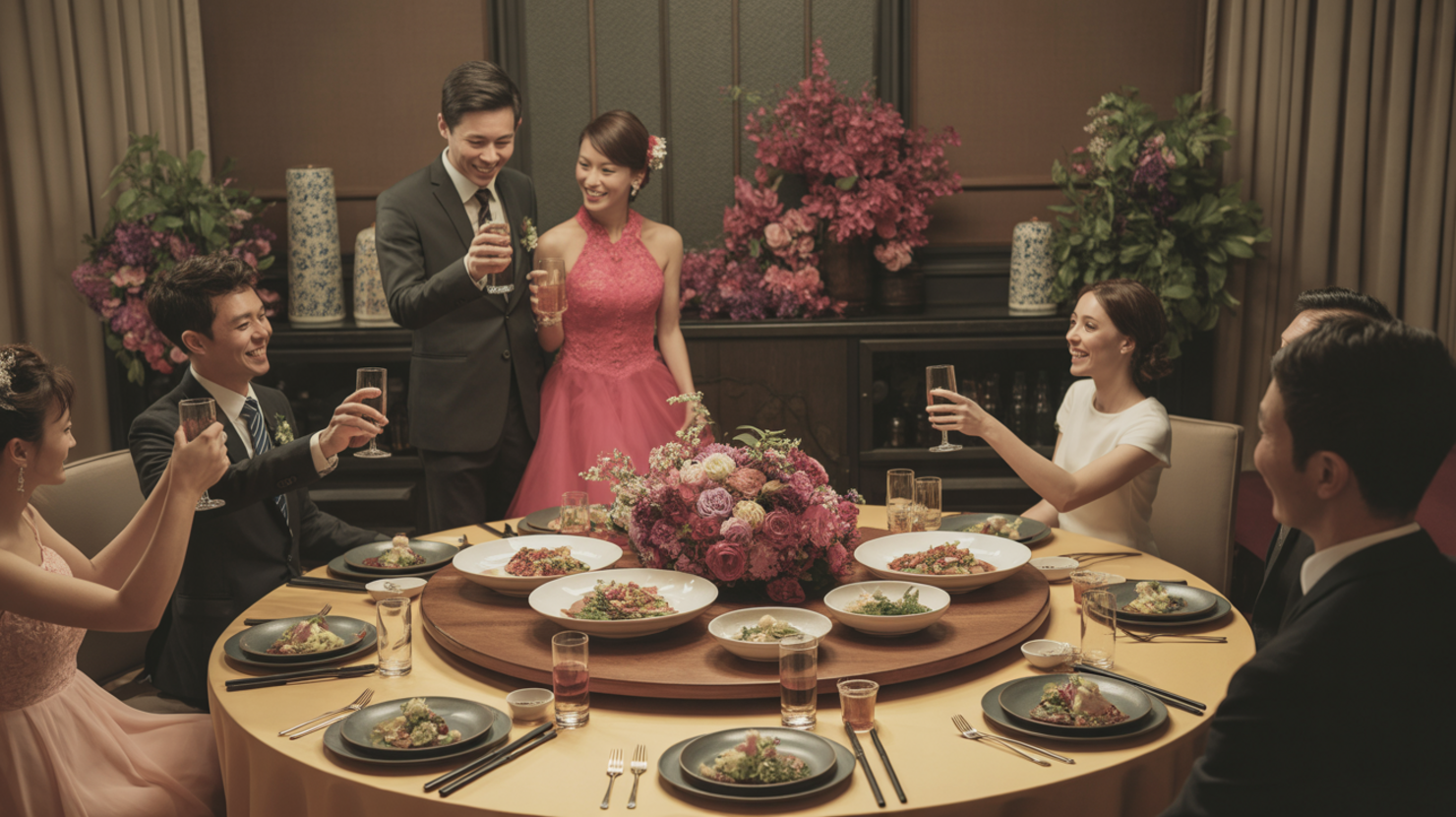Why Seasonality Dictates Chinese Wedding Menus
When planning a traditional Chinese wedding banquet in vibrant Hong Kong, the menu isn’t just about delicious dishes; it’s deeply rooted in tradition and cultural significance. One of the most fundamental factors dictating the culinary choices is seasonality. It’s far more than just a modern farm-to-table trend; it’s a centuries-old practice tied to auspicious timing, optimal flavour, and philosophical beliefs about harmony.
Unlike Western calendars, many traditional Chinese wedding dates historically align with the lunar calendar. This ancient system dictates festivals and agricultural cycles. Choosing dates in auspicious lunar periods naturally connects the timing with ingredients at their seasonal best, ensuring the banquet reflects the year’s bounty and complements the chosen date’s significance. Learn more about the Chinese lunar calendar.
At its core, seasonality is about maximizing flavour. Ingredients harvested at their peak season offer the most vibrant tastes, optimal textures, and highest nutritional value. For a sophisticated wedding banquet, where every dish aims to impress, using seasonal ingredients is paramount. Think of succulent crabs in autumn or crisp, cooling vegetables in summer; their quality is simply unmatched. This focus on peak flavour elevates the dining experience significantly.
Beyond taste, seasonality links to Chinese cultural beliefs about harmony. Traditional Chinese medicine and culinary philosophy emphasize balance, often called Yin and Yang. Some foods are warming (Yang) for colder months, others cooling (Yin) for warmer weather. Building a menu around seasonal ingredients promotes physical well-being and reflects the desired balance for the couple and guests. It’s a symbolic act wishing good health and a balanced life. Discover more about Yin and Yang principles.
Ultimately, incorporating seasonality into a Chinese wedding menu is a deliberate choice that honours tradition, celebrates the freshest ingredients, and upholds deep-seated cultural values of balance and harmony. It transforms the meal from a simple feast into a meaningful part of the wedding celebration itself.
Spring/Summer Menu Essentials for Hong Kong
As the seasons shift in Hong Kong from cooler autumn and winter to the warmer, more humid embrace of spring and summer, so too do the essentials of a traditional Chinese wedding banquet menu. The focus moves towards dishes that are lighter, refreshing, and help guests stay comfortable while celebrating.
A prime example is the preparation of the ever-important fish course. Instead of the heartier, braised, or rich preparations favoured in winter, spring and summer banquets typically feature lightly steamed fish. This method highlights the delicate flavour of fresh seafood and is considered “cooling” in traditional Chinese medicine principles, perfectly suited for the warmer climate. Using peak-season catches ensures the best possible taste and texture.
To combat the high humidity, cooling melon soups are a staple inclusion. These often feature ingredients like winter melon, known for its refreshing and hydrating properties. These soups are served towards the beginning of the banquet, offering a soothing contrast to richer dishes and providing a welcome respite from the heat outside.
Completing the seasonal adaptation are the desserts. While sweet dishes are always symbolic, the warmer months often highlight options like lotus seed desserts. These are not only sweet and enjoyable but also carry significant fertility symbolism, making them highly auspicious for a wedding. Their slightly chewy texture and subtle sweetness offer a pleasant finish to the meal without being overly heavy.
Incorporating these elements ensures that a spring or summer wedding banquet in Hong Kong is not only delicious and symbolically rich but also thoughtfully adapted to the seasonal climate, providing a comfortable and memorable dining experience for all guests. The emphasis remains on harmony through food, aligning the celebration with the natural rhythm of the year.
Autumn/Winter Banquet Staples and Innovations
As the seasons shift towards the cooler months, the focus of a traditional Hong Kong Chinese wedding banquet menu often transitions as well. Autumn and winter call for dishes that are more warming, rich, and comforting, providing a sense of nourishment and heartiness perfectly suited for the crisp air. This doesn’t mean sacrificing elegance or tradition; rather, it’s about selecting ingredients and preparations that shine during this time of year, often incorporating both time-honored staples and exciting modern innovations.
One quintessential dish that embodies the spirit of autumn and winter banquets is braised pork belly with preserved vegetables. This classic delivers deep, savory flavors and a wonderfully tender texture that is both satisfying and symbolic of abundance. Its rich profile makes it a favorite for cooler weather gatherings, offering a hearty course that guests truly appreciate. The balance of the fatty pork with the tangy, complex notes of preserved vegetables creates a harmonious blend, a hallmark of traditional Chinese cooking perfectly suited for a grand celebration in the cooler season.
Beyond the heartier main courses, even luxurious staples see seasonal or modern adaptations. Consider bird’s nest soup, a highly prized delicacy often included for its perceived health benefits and symbolic significance of good fortune and prosperity for the newlyweds. While the core ingredient remains constant, autumn and winter presentations might feature slightly different broths or garnishes. More notably, chefs are exploring modern twists on bird’s nest soup presentations, perhaps serving it in individual delicate vessels or incorporating subtle flavor enhancements that appeal to contemporary palates while still honoring its traditional place in the banquet structure. These updates keep the classic relevant and visually stunning.
Innovation also plays a role in keeping banquets fresh and engaging. For autumn and winter weddings, one trending option is integrating hotpot fusion elements for an interactive dining experience. While a full hotpot might be unconventional for a formal banquet, chefs are finding ways to incorporate the concept – perhaps through a luxurious mini hotpot course featuring premium seafood or specialty broths, allowing guests a personalized, warm, and communal moment. This adds a dynamic, engaging element that is particularly welcoming on a chilly evening, blending traditional communal eating styles with modern banquet sophistication.
Ultimately, autumn and winter Chinese wedding menus in Hong Kong are about curating an experience that is both deeply rooted in tradition and open to contemporary creativity. By featuring warming, flavorful staples like braised pork belly alongside elegant, modern interpretations of classics and innovative concepts, couples can craft a banquet that is perfectly suited to the season and memorable for all attendees, ensuring a warm and joyful celebration regardless of the temperature outside.
Non-Negotiable Traditional Course Breakdown
While seasonality brings delightful variations to Chinese wedding banquet menus in Hong Kong, some dishes are considered absolute staples. These time-honored courses carry deep cultural significance and are expected at virtually every celebration, regardless of the time of year. They represent blessings, prosperity, and completeness for the new couple.
Here are some key traditional courses and their symbolism:
- Roast Suckling Pig (乳豬): A ceremonial centerpiece symbolizing the bride’s purity and the groom’s strength. Served whole with head and tail, it signifies a prosperous start and completeness.
- “Double Happiness” Lobster (龍蝦): Typically stir-fried with noodles or rice. The name represents marital bliss, while the pairing of lobster (dragon) and noodles/rice (phoenix) embodies the traditional bridal pairing.
- Sweet Soups (紅豆沙/芝麻糊): Traditionally served at the end, either sweet red bean soup or black sesame soup. Red bean symbolizes fertility and togetherness, while black sesame is associated with longevity and well-being. Both provide a comforting, auspicious conclusion.
These key dishes form the backbone of a traditional Chinese wedding banquet menu in Hong Kong, ensuring that cultural heritage and auspicious symbolism are celebrated alongside culinary excellence.
Learn more about the traditional structure of a Chinese banquet.
Regional Influences in Hong Kong Menus
While Cantonese cuisine forms the heart of most traditional Hong Kong wedding banquets, the city’s status as a cosmopolitan hub means influences from other regional Chinese cooking styles often feature prominently. These additions add layers of flavor, texture, and variety, showcasing the breadth of Chinese gastronomy.
One of the most noticeable influences appears in the preparation of seafood, a cornerstone of any auspicious banquet. Comparing Cantonese and Teochew seafood approaches highlights this variation. Cantonese methods often emphasize steaming the freshest fish or shellfish to preserve their delicate natural flavors. In contrast, Teochew cuisine, also popular in Hong Kong, frequently incorporates rich braising techniques or complex stews, often featuring ingredients like sea cucumber or abalone with deeper sauces. This offers couples options to add bolder, more savory seafood dishes alongside classic steamed preparations.
Further diversifying the menu, Shanghainese cold appetizer adaptations have found a welcome place at the start of the banquet. Traditionally, a banquet begins with a platter of cold cuts. While Cantonese cold appetizers are common, incorporating Shanghainese specialties like drunken chicken (chicken marinated in Shao Xing wine) or smoked fish introduces distinct, often slightly sweet or intensely aromatic flavors that set the stage for the courses to follow. These dishes provide a refreshing contrast before the parade of hot, rich main dishes.
Increasingly, modern banquet menus even dare to introduce elements from spicier regions. Sichuan pepper accents in modern pairings can be found in creative dishes that offer a gentle tingle without overpowering the palate. This isn’t about serving fiery Sichuan main courses, but rather subtle incorporations – perhaps a sauce with a hint of numbing spice paired with a seafood dish, or a modern take on a meat course that features a controlled use of Sichuan peppercorn for aroma and a unique mouthfeel. These daring inclusions appeal to couples and guests seeking a contemporary edge.
These regional influences ensure that Hong Kong wedding banquet menus are far from monotonous, offering a dynamic culinary journey that reflects the city’s vibrant cultural tapestry.
Symbolism Behind Key Wedding Ingredients
Chinese wedding banquets are far more than just a delicious feast; they are rich tapestries woven with cultural significance. Almost every dish and ingredient placed before guests carries a deeper meaning, serving as auspicious blessings for the newlyweds. Understanding this symbolism adds a profound layer to the dining experience, connecting modern celebrations to centuries of tradition.
A prominent fixture on many tables is the whole chicken. Typically served with the head and tail intact, this presentation is crucial. It symbolizes completeness and unity within the marriage. The intact form signifies a good beginning and end, representing a wish for the couple to enjoy a full, perfect, and harmonious life together, complete in every aspect.
Towards the end of the banquet, you’ll often find sticky rice cakes, known as *nian gao* (年糕). These sweet, glutinous treats hold powerful symbolism. *Nian gao* sounds similar to “higher year” in Mandarin, representing growth, advancement, and prosperity year after year. For a wedding couple, it beautifully symbolizes their desire to stick together through thick and thin, signifying unity and the hope for a progressively better future together.
Another sweet symbol frequently included are lychee nuts. The Chinese name for lychee, *lìzhī* (荔枝), sounds somewhat like the phrase “to have sons” (利子, *lì zǐ* or 立子, *lì zǐ*). This connection traditionally symbolizes the blessing of a fertile marriage and the hope for future generations. Beyond this specific interpretation, lychees represent sweetness, happiness, and abundant blessings bestowed upon the newlyweds and their union.
These are just a few examples, but they highlight how foundational ingredients in a Chinese wedding banquet are carefully chosen not just for their flavor, but for the powerful, positive messages they convey. Each bite is steeped in tradition, wishing the couple longevity, prosperity, happiness, and togetherness as they embark on their new life.
Customizing Menus for Modern Preferences
While the heart of a Hong Kong Chinese wedding banquet remains rooted in rich tradition and symbolism, modern couples are increasingly seeking ways to personalize their menus. This isn’t about discarding heritage, but rather finding a harmonious balance that reflects contemporary tastes, values, and guest needs, ensuring the celebration is both meaningful and inclusive for everyone present.
One of the most significant shifts is the move towards ethical and sustainable dining. The traditional inclusion of dishes like shark fin soup, long seen as a status symbol, is now often reconsidered due to environmental and ethical concerns. Modern couples frequently opt for delicious and symbolic alternatives, such as rich mushroom broth, innovative vegetarian “shark fin” preparations made from ingredients like konjac, or other auspicious seafood soups that carry similar cultural weight without the controversy. This allows the banquet to honor tradition while aligning with the couple’s modern values.
Another crucial aspect of modern customization is prioritizing guest dietary needs and allergies. With diverse guest lists, it’s essential to offer options beyond the standard banquet fare. This includes not just vegetarian or vegan choices, but also accommodations for common allergies like nuts, seafood, or gluten. Experienced caterers in Hong Kong are becoming adept at creating allergy-conscious substitutions or providing alternative plates that maintain the celebratory feel without putting guests at risk. Open communication with your venue and caterer about specific requirements is key to ensuring every guest feels welcomed and cared for.
Finally, the trend towards mini portions or tasting-menu style presentations is gaining popularity. Traditional banquets are known for their generous, large-format dishes served family-style. Modern couples sometimes prefer a more curated experience with smaller, individually plated servings. This allows guests to sample a wider variety of dishes throughout the multi-course meal without feeling overwhelmed and can also help reduce food waste. It offers a contemporary twist on the traditional banquet structure, focusing on refined presentation and a diverse culinary journey for guests.
Future Trends in Wedding Banquet Planning
Hong Kong’s vibrant wedding scene is always evolving, and while tradition remains foundational, future banquet trends are set to embrace sustainability, technology, and deeper connections to provenance. Couples are increasingly looking for ways to make their special day not only memorable but also align with their values and modern sensibilities.
One significant shift is towards hyper-local sourcing, particularly for heritage vegetables and specialty produce. This isn’t just about freshness; it tells a story. Imagine a dish featuring ingredients sourced from a specific farm in the New Territories, connecting guests to Hong Kong’s agricultural roots. This trend supports local producers, reduces the carbon footprint associated with transportation, and offers a truly unique culinary experience that guests won’t find anywhere else. It elevates the meal beyond just taste to a narrative about the food’s journey and origin.
Aligning with a global movement, zero-waste menu engineering is becoming a key focus for environmentally conscious couples and caterers. This involves meticulous planning to minimize food waste, utilizing ingredients from root to stem, and exploring creative ways to repurpose leftovers or donate edible surplus. It also extends to reducing packaging and choosing sustainable practices throughout the catering process. Embracing zero-waste isn’t just ethical; it can also encourage culinary innovation and efficient resource management, reflecting a commitment to the planet. (Learn more about reducing food waste)
Technology is also set to transform the planning process. We’re seeing exciting developments like digital tasting sessions and augmented reality (AR) menus. Imagine previewing your banquet menu from home, perhaps even experiencing a virtual tour of dishes or the venue’s setup. AR menus could offer interactive elements, showing details about ingredients or preparation methods simply by pointing a device at the menu card. These innovations make planning more convenient and offer an engaging preview of the culinary delights awaiting guests, especially valuable for couples planning remotely. (Explore AR in hospitality)
Ultimately, these future trends reflect a desire for banquets that are more than just a meal; they are becoming expressions of a couple’s identity and values. They promise events that are not only delicious but also deeply meaningful, sustainable, and technologically advanced, setting a new standard for wedding celebrations in Hong Kong.



